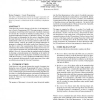401 search results - page 15 / 81 » Genetic Programming Theory and Practice |
EUROGP
2005
Springer
14 years 29 days ago
2005
Springer
Abstract. Wireless sensor networks (WSNs) are medium scale manifestations of a paintable or amorphous computing paradigm. WSNs are becoming increasingly important as they attain gr...
GECCO
2005
Springer
14 years 1 months ago
2005
Springer
Code bloat, the excessive increase of code size, is an important issue in Genetic Programming (GP). This paper proposes a theoretical analysis of code bloat in the framework of sy...
GECCO
2008
Springer
13 years 8 months ago
2008
Springer
The parsimony pressure method is perhaps the simplest and most frequently used method to control bloat in genetic programming. In this paper we first reconsider the size evolutio...
PLDI
2004
ACM
14 years 28 days ago
2004
ACM
Many program analyses can be reduced to graph reachability problems involving a limited form of context-free language reachability called Dyck-CFL reachability. We show a new redu...
CSB
2004
IEEE
13 years 11 months ago
2004
IEEE
In theory, it should be possible to infer realistic genetic networks from time series microarray data. In practice, however, network discovery has proved problematic. The three ma...

